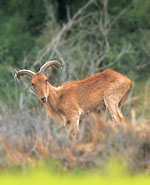|
1
|
| |
The fastest bird in the world
lives in Tunisia in the rocky cliffs of the Tunisian
mountains.
It is the peregrine
falcon (falco peregrinus).
It has a cruising speed of 110 km/h and can reach
300 km/h when he is diving to its prey.
|
|
|
|
2
|
| |
The Gabes gulf
alone shelters in winter half the amount of birds
hibernating in the Mediterranean, something like 350.000
pieces, waders, limicoles, ducks and other water birds.
A paradise for bird lovers.
|
|
|
|
|
|
4
|
| |
In the National park of Chaambi, the striped hyena,
sole species in north africa shares the place with the
mouflon
a manchettes and the mountain
gazelle.
|
|
|
|
5
|
| |
Unless the inhospitality of the desert,
it remains rich in fauna and flora.
One of its examples is the fouette
queue, a lizard well adapted, as he is exclusively
vegetarian.
|
|
|
|
6
|
| |
The short distance between the south and north of the
country is no obstacle to its multitude of ecosystems.
You go from desert to forests, containing very diversified
flora like the orchids,
those plants situated at the summit of mimetism and
plant evolution, who colonize the whole north of the
conuntry. |
|
|
|
|
7
|
| |
The smallest mammal
in the world hidess in the Tunisian mountains.
Weighing 2 to 3 g and with a length of 7 cm he lives
in holes and is named Estruscan shrew.
|
|
|
|
8
|
| |
The
royal eagle, lord of the Tunisian cliffs, is
one of the biggest eagles in Africa.
He surveys the migrating birds leaving the Sahara for
Europe. |
|
|
|
9
|
| |
The saying "Tunisia, gazelles' paradise" is
proven by the existence of 4 different species of gazelles
on his territory, in the different ecosystems, the Dorcas,
Mohr, Rym
and mountain
gazelles. |
|
|
|
|
10
|
| |
The biggest grotto
known in north Africa is situated in the chalky mountains. |
|
|
|
11
|
| |
In the region of Medenine, Tunisia possesses a geological
marvel
:
the only outcrop of a geological layer, dating from
the permien primary age (250 million years of age).
|
|
|
|
|

